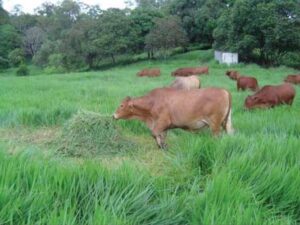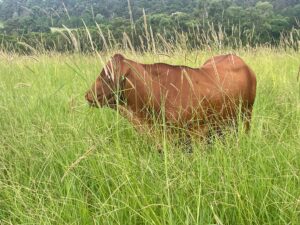Calculating dry matter content of pastures
The importance of dry matter
Water content of pastures needs to be considered in the management of cattle during the wetter months.
You have no doubt heard dry matter as being referred to as the critical ingredient in ruminant nutrition. It is the first consideration we make in pasture fed systems to ensure that the stocks’ appetite are satisfied.
The average rate of daily consumption by a ruminant is around 2.2% of body weight in dry matter per day. Using the standard Adult Equivalent with a weight of 450 kilograms as an example, average daily consumption would be around 10 kilograms of dry matter. However, what happens if the dry matter content of a pasture is less than a quarter of the overall bulk weight?
A real life example…
During the wet season of 2010, pastures in the Mackay Whitsunday region had been subjected to long periods of rainfall and very few hours of sunlight. Pastures had responded to the season and had grown vigorously but cattle were still lagging in their body condition.
A study was conducted on signal grass pastures north-east of Habana looking at dry matter content in feed.
The study showed that in some areas dry matter content was as low as 13% of total pasture yield.

The steers that were grazing these pastures averaged 500 kilograms, meaning their feed requirement at 2.2% of body weight was around 11 kilograms of dry matter.
In order to meet their feed demand from this pasture that was 86% water, the steers needed to consume around 84 kilograms of grass per day.
Photo 1 shows that amount of grass harvested in a pile next to the steer. It is easy to see that the animal would have difficulty with that level of consumption.
This exert has been reproduced from Pasture Photo Standards for the Mackay Whitsunday Region.
How to test the dry matter of your pasture
Step 1
Use a set of hand shears to collect all standing pasture in a 0.5m x 0.5m area to about 2cm above ground level. Place the sample in a large, labelled paper bag.
Step 2
Tare a set of scales using an identical, empty paper bag.
Step 3
Weigh the freshly cut sample after the scales have been tared (if the sample is big and bulky, take a random sub-sample from the bag, put it into another paper bag of the same size and weigh the fresh sub-sample with the tared scales.
Step 4
Place the sample bag in the microwave with a cup of water. Ensure that you empty the cup and use cool water each time you dry the sample, as the microwave can malfunction if the water evaporates and the atmosphere gets too dry.
Step 5
Microwave for 1 minute on high and weigh the sample. Remember to discard the hot water and replace it with cold water before microwaving again.
Step 6
Repeat step 5, weighing the sample after each drying cycle until the sample is dry and brittle to touch and is no longer losing weight each time it is dried. This may take a number of repetitions.
Step 7

Record the final dried sample weight using the tared scales.
Step 8
Convert the sub sample to percent dry matter using the following equation:
Dried sample weight ÷ sample wet weight x 100
For example:
Dried sample weight 76g ÷ 102g x 100 = 74.5% dry matter (Photo 2).
More information
Pasture Photo Standards for the Mackay Whitsunday Region →
Dry season pasture budget: a guide for stocking rates →
Matching stocking rates with available forage →